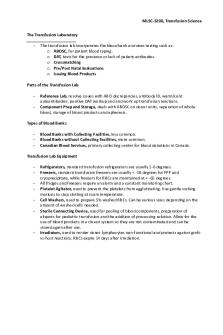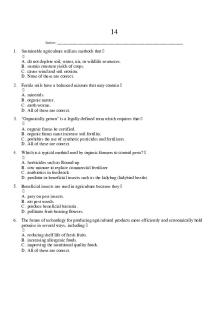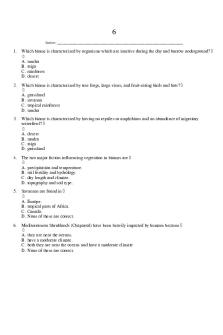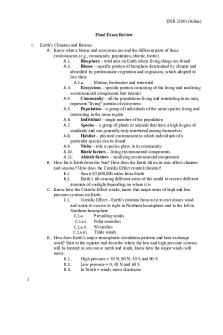17 - An intro to environmental science course PDF

| Title | 17 - An intro to environmental science course |
|---|---|
| Course | Environmental Science |
| Institution | American University of Sharjah |
| Pages | 21 |
| File Size | 203.4 KB |
| File Type | |
| Total Downloads | 49 |
| Total Views | 173 |
Summary
An intro to environmental science course...
Description
17 Student: ___________________________________________________________________________
1.
Container deposit-refund programs are the original A. product stewardship programs. B. beverage disposal programs. C. deposit resignation systems. D. None of these are correct.
2.
The management of municipal solid waste is directly affected by A. economics. B. changes in technology. C. citizen awareness and involvement. D. All of these are correct.
3.
Agricultural waste is the _____ most common form of waste. A. first B. second C. third D. fourth
4.
The United States and ________ are among the world's leaders in waste production. A. Britain B. Mexico C. Canada D. China
5.
Approximately ______ municipal solid waste landfills in the United States combust landfill gas to generate heat and electricity. A. 100 B. 400 C. 600 D. 800
6.
Which of the following statements regarding the impact of landfills on water is correct? A. Landfills should be located below the water table. B. Landfills should be surrounded by highly permeable soils. C. Landfills should have 2 or more liners along with a leachate collection system above and between liners. D. Landfills should not have liners in order to allow leachate to disperse and dilute within the groundwater.
7.
In Ireland, the Environment Minister launched a program to tax plastic bags called A. brass tax. B. green tax. C. plastax. D. None of these are correct.
8.
Mining waste is generated in _____ primary ways. A. two B. three C. four D. five
9.
One effect of the 1972 Oregon Bottle Bill was that A. beverage-container litter decreased by about 49 percent. B. more one-time-use bottles were used. C. hundreds of jobs were lost. D. it led to a national Bottle Bill.
10. Waste prevention is also known as A. composting. B. recycling. C. source reduction. D. waste toxicity. 11. In addition to keeping wastes from entering a landfill, composting also A. adds bulk to soil. B. increases porosity of the soil. C. adds nutrients to the soil D. All of these are correct. E. Increases porosity of the soil and adds nutrients to the soil are correct. 12. In which method of composting are compostables formed into long rows and aerated? A. large-scale composting B. static aerated pile C. windrow composting D. enclosed vessel composting 13. Which of the following is NOT a method of source reduction? A. reduce the weight of the packaging B. reduce the layers of packaging C. use of PCV valves D. municipal composting
14. The major problem with recycling plastics is A. the lack of steady supply. B. the inability to mix plastics. C. the lack of current markets. D. the taxes imposed on the recycled product. 15. The establishment of a recycling exchange on the Chicago Board of Trade allows A. the federal government to control the prices of recycled materials. B. consumers and producers to participate in an efficient recyclable materials market. C. individual consumers to purchase recycled materials on-line. D. for mandatory trash separation and recycling programs in schools. 16. The purpose of state "bottle bills" is A. to reduce the amount of one-time-use beverage containers. B. to raise tax money to pay for waste disposal. C. to reduce the air pollution from the manufacture of plastic bottles. D. All of these are correct. 17. Which of the following is NOT a thermoplastic? A. polystyrene B. polyvinyl chloride C. polyethylene D. None of these are correct. 18. Landfills today are usually referred to as A. municipal solid waste disposal sites. B. sanitary landfills. C. garbage disposal sites. D. EPA Class I disposal sites. 19. The most immediate problem resulting from the increase in solid waste is A. heavy barge and truck traffic. B. increased garbage fees. C. increased air pollution. D. a shortage of space in landfills. 20. The selection of a modern landfill site is based on A. understanding groundwater geology. B. soil type. C. sensitivity to local citizens' concerns. D. All of these are correct.
21. Future management of municipal solid waste will be an integrated approach involving A. landfilling. B. incineration. C. source reduction. D. recycling. E. All of these are correct. 22. In Arizona, how is the recycling partnership between the city of Flagstaff and Northern Arizona University helping to reduce greenhouse gas emissions from 1,128 metric tons per year? A. by encouraging students to buy textbooks printed exclusively on recycled paper B. by using a recycling program to divert 21 tons of recyclable materials from the landfill C. by using recycled water from the municipal wastewater treatment plant to maintain and irrigate landscaping D. None of these are correct. 23. In a modern landfill, the water that leaches from the site A. is virtually contaminant free. B. collects in the groundwater. C. is pumped into a leachate treatment system. D. is vaporized to remove contaminants. 24. In the mass burn technique, A. water is heated and the steam drives a turbine to generate electricity. B. huge quantities of waste are burned at low temperatures for a long period of time. C. ash and particulates are vaporized into the atmosphere. D. All of these are correct. 25. Which countries account for 80-90% of the hazardous waste generated worldwide? A. OPEC countries B. IUCN countries C. FAO countries D. OECD countries 26. The most common method of waste disposal is A. incineration. B. source reduction. C. burying in landfills. D. recycling. 27. The greatest source of waste material today is A. food waste. B. yard waste. C. paper and paperboard. D. organic wastes.
28. Which of the following is a problem with solid waste disposal? A. cost B. groundwater hazard C. maintaining air quality D. All of these are correct. 29. Which of the following is NOT a method of waste disposal? A. incineration B. secondary recovery C. landfills D. recycling Which of the following best matches the description? 30. Organic material used to cover soil. A. source reduction B. incineration C. municipal solid waste D. mass burn E. recycling F. municipal landfill G. forced consumption H. disposable I. NIMBY J. mulch 31. Term used to describe a product which is used once and thrown away. A. source reduction B. incineration C. municipal solid waste D. mass burn E. recycling F. municipal landfill G. forced consumption H. disposable I. NIMBY J. mulch 32. Process of reclaiming a resource and reusing it. A. source reduction B. incineration C. municipal solid waste D. mass burn E. recycling F. municipal landfill G. forced consumption H. disposable I. NIMBY J. mulch
33. Waste produced by the residents of a community. A. source reduction B. incineration C. municipal solid waste D. mass burn E. recycling F. municipal landfill G. forced consumption H. disposable I. NIMBY J. mulch 34. An area used for the containment of solid wastes. A. source reduction B. incineration C. municipal solid waste D. mass burn E. recycling F. municipal landfill G. forced consumption H. disposable I. NIMBY J. mulch 35. Method of disposing of solid waste by burning. A. source reduction B. incineration C. municipal solid waste D. mass burn E. recycling F. municipal landfill G. forced consumption H. disposable I. NIMBY J. mulch 36. Syndrome in which there is local opposition to the location of landfills and other sources of pollution. A. source reduction B. incineration C. municipal solid waste D. mass burn E. recycling F. municipal landfill G. forced consumption H. disposable I. NIMBY J. mulch
37. The notion that our economy demands ritualistic buying and use of goods. A. source reduction B. incineration C. municipal solid waste D. mass burn E. recycling F. municipal landfill G. forced consumption H. disposable I. NIMBY J. mulch 38. Reducing the amount of solid waste generated by using less. A. source reduction B. incineration C. municipal solid waste D. mass burn E. recycling F. municipal landfill G. forced consumption H. disposable I. NIMBY J. mulch 39. A type of incineration of solid waste. A. source reduction B. incineration C. municipal solid waste D. mass burn E. recycling F. municipal landfill G. forced consumption H. disposable I. NIMBY J. mulch 40. The primary means of municipal solid waste disposal is incineration. True False 41. In 2004, 30% of municipal solid waste was recycled. True False 42. Recycle Bank encourages people to recycle through a points earning system where points can be redeemed at merchants like CVS. True False
43. An example of source reduction is making a product lightweight. True False 44. Municipal composting is a modern type of landfill. True False 45. About 65 percent of the waste generated is handled through recycling. True False 46. The long-term success of recycling programs is tied to economic incentives. True False 47. Future waste management will require only recycling and reduction, and no incineration or landfills. True False 48. Windrow composting is a process whereby compostable materials are fed into an environmentally controlled enclosed structure and allowed to decompose over time. True False 49. One of the main problems associated with mining is water pollution. True False 50. The current problem with recycling is the inability to mix different plastics. True False 51. Nations with a low standard of living and productivity tend to have more municipal solid waste per person. True False 52. In a modern landfill, the "cell" is sealed when it is filled and the adjacent groundwater is continuously monitored. True False 53. The primary risk from incineration is the risk of contaminants leaching from the ash. True False 54. The number of incinerators has declined over the past several decades. True False 55. Incineration is the primary means of waste disposal used today. True False
56. Japan recycles more of its waste than the U.S. True False 57. There are both benefits and drawbacks to recycling. True False 58. Agricultural waste is the most common form of solid waste. True False 59. Archaeologists rely on the waste of past societies to tell them about the nature of the culture and lifestyles of ancient civilizations. True False 60. Landfills have historically been the secondary method of waste disposal. True False 61. Mass burn technology uses unprocessed municipal solid waste to generate heat which is used to produce electricity. True False 62. Nations with high standards of living and productivity tend to have less municipal solid waste per person than less developed countries. True False 63. New York City recently closed its Fresh Kills Landfill on Staten Island, thus ending the life of the world's largest landfill. True False
17 Key 1.
Container deposit-refund programs are the original A. product stewardship programs. B. beverage disposal programs. C. deposit resignation systems. D. None of these are correct. Enger - Chapter 17 #1
2.
The management of municipal solid waste is directly affected by A. economics. B. changes in technology. C. citizen awareness and involvement. D. All of these are correct. Enger - Chapter 17 #2
3.
Agricultural waste is the _____ most common form of waste. A. first B. second C. third D. fourth Enger - Chapter 17 #3
4.
The United States and ________ are among the world's leaders in waste production. A. Britain B. Mexico C. Canada D. China Enger - Chapter 17 #4
5.
Approximately ______ municipal solid waste landfills in the United States combust landfill gas to generate heat and electricity. A. 100 B. 400 C. 600 D. 800 Enger - Chapter 17 #5
6.
Which of the following statements regarding the impact of landfills on water is correct? A. Landfills should be located below the water table. B. Landfills should be surrounded by highly permeable soils. C. Landfills should have 2 or more liners along with a leachate collection system above and between liners. D. Landfills should not have liners in order to allow leachate to disperse and dilute within the groundwater. Enger - Chapter 17 #6
7.
In Ireland, the Environment Minister launched a program to tax plastic bags called A. brass tax. B. green tax. C. plastax. D. None of these are correct. Enger - Chapter 17 #7
8.
Mining waste is generated in _____ primary ways. A. two B. three C. four D. five Enger - Chapter 17 #8
9.
One effect of the 1972 Oregon Bottle Bill was that A. beverage-container litter decreased by about 49 percent. B. more one-time-use bottles were used. C. hundreds of jobs were lost. D. it led to a national Bottle Bill. Enger - Chapter 17 #9
10.
Waste prevention is also known as A. composting. B. recycling. C. source reduction. D. waste toxicity. Enger - Chapter 17 #10
11.
In addition to keeping wastes from entering a landfill, composting also A. adds bulk to soil. B. increases porosity of the soil. C. adds nutrients to the soil D. All of these are correct. E. Increases porosity of the soil and adds nutrients to the soil are correct. Enger - Chapter 17 #11
12.
In which method of composting are compostables formed into long rows and aerated? A. large-scale composting B. static aerated pile C. windrow composting D. enclosed vessel composting Enger - Chapter 17 #12
13.
Which of the following is NOT a method of source reduction? A. reduce the weight of the packaging B. reduce the layers of packaging C. use of PCV valves D. municipal composting Enger - Chapter 17 #13
14.
The major problem with recycling plastics is A. the lack of steady supply. B. the inability to mix plastics. C. the lack of current markets. D. the taxes imposed on the recycled product. Enger - Chapter 17 #14
15.
The establishment of a recycling exchange on the Chicago Board of Trade allows A. the federal government to control the prices of recycled materials. B. consumers and producers to participate in an efficient recyclable materials market. C. individual consumers to purchase recycled materials on-line. D. for mandatory trash separation and recycling programs in schools. Enger - Chapter 17 #15
16.
The purpose of state "bottle bills" is A. to reduce the amount of one-time-use beverage containers. B. to raise tax money to pay for waste disposal. C. to reduce the air pollution from the manufacture of plastic bottles. D. All of these are correct. Enger - Chapter 17 #16
17.
Which of the following is NOT a thermoplastic? A. polystyrene B. polyvinyl chloride C. polyethylene D. None of these are correct. Enger - Chapter 17 #17
18.
Landfills today are usually referred to as A. municipal solid waste disposal sites. B. sanitary landfills. C. garbage disposal sites. D. EPA Class I disposal sites. Enger - Chapter 17 #18
19.
The most immediate problem resulting from the increase in solid waste is A. heavy barge and truck traffic. B. increased garbage fees. C. increased air pollution. D. a shortage of space in landfills. Enger - Chapter 17 #19
20.
The selection of a modern landfill site is based on A. understanding groundwater geology. B. soil type. C. sensitivity to local citizens' concerns. D. All of these are correct. Enger - Chapter 17 #20
21.
Future management of municipal solid waste will be an integrated approach involving A. landfilling. B. incineration. C. source reduction. D. recycling. E. All of these are correct. Enger - Chapter 17 #21
22.
In Arizona, how is the recycling partnership between the city of Flagstaff and Northern Arizona University helping to reduce greenhouse gas emissions from 1,128 metric tons per year? A. by encouraging students to buy textbooks printed exclusively on recycled paper B. by using a recycling program to divert 21 tons of recyclable materials from the landfill C. by using recycled water from the municipal wastewater treatment plant to maintain and irrigate landscaping D. None of these are correct. Enger - Chapter 17 #22
23.
In a modern landfill, the water that leaches from the site A. is virtually contaminant free. B. collects in the groundwater. C. is pumped into a leachate treatment system. D. is vaporized to remove contaminants. Enger - Chapter 17 #23
24.
In the mass burn technique, A. water is heated and the steam drives a turbine to generate electricity. B. huge quantities of waste are burned at low temperatures for a long period of time. C. ash and particulates are vaporized into the atmosphere. D. All of these are correct. Enger - Chapter 17 #24
25.
Which countries account for 80-90% of the hazardous waste generated worldwide? A. OPEC countries B. IUCN countries C. FAO countries D. OECD countries Enger - Chapter 17 #25
26.
The most common method of waste disposal is A. incineration. B. source reduction. C. burying in landfills. D. recycling. Enger - Chapter 17 #26
27.
The greatest source of waste material today is A. food waste. B. yard waste. C. paper and paperboard. D. organic wastes. Enger - Chapter 17 #27
28.
Which of the following is a problem with solid waste disposal? A. cost B. groundwater hazard C. maintaining air quality D. All of these are correct. Enger - Chapter 17 #28
29.
Which of the following is NOT a method of waste disposal? A. incineration B. secondary recovery C. landfills D. recycling Enger - Chapter 17 #29
Which of the following best matches the description? Enger - Chapter 17
30.
Organic material used to cover soil. A. source reduction B. incineration C. municipal solid waste D. mass burn E. recycling F. municipal landfill G. forced consumption H. disposable I. NIMBY J. mulch Enger - Chapter 17 #30
31.
Term used to describe a product which is used once and thrown away. A. source reduction B. incineration C. municipal solid waste D. mass burn E. recycling F. municipal landfill G. forced consumption H. disposable I. NIMBY J. mulch Enger - Chapter 17 #31
32.
Process of reclaiming a resource and reusing it. A. source reduction B. incineration C. municipal solid waste D. mass burn E. recycling F. municipal landfill G. forced consumption H. disposable I. NIMBY J. mulch Enger - Chapter 17 #32
33.
Waste produced by the residents of a community. A. source reduction B. incineration C. municipal solid waste D. mass burn E. recycling F. municipal landfill G. forced consumption H. disposable I. NIMBY J. mulch Enger - Chapter 17 #33
34.
An area used for the containment of solid wastes. A. source reduction B. incineration C. municipal solid waste D. mass burn E. recycling F. municipal landfill G. forced consumption H. disposable I. NIMBY J. mulch Enger - Chapter 17 #34
35.
Method of disposing of solid waste by burning. A. source reduction B. incineration C. municipal solid waste D. mass burn E. recycling F. municipal landfill G. forced consumption H. disposable I. NIMBY J. mulch Enger - Chapter 17 #35
36.
Syndrome in which there is local opposition to the location of landfills and other sources of pollution. A. source reduction B. incineration C. municipal solid waste D. mass burn E. recycling F. municipal landfill G. forc...
Similar Free PDFs

Intro to Transfusion Science
- 3 Pages

Environmental Science
- 16 Pages

Intro to Psych Course Notes
- 44 Pages

BIO LAB Intro to Science
- 12 Pages

Environmental Science Module 1
- 4 Pages

Environmental Science and Engineering
- 109 Pages
Popular Institutions
- Tinajero National High School - Annex
- Politeknik Caltex Riau
- Yokohama City University
- SGT University
- University of Al-Qadisiyah
- Divine Word College of Vigan
- Techniek College Rotterdam
- Universidade de Santiago
- Universiti Teknologi MARA Cawangan Johor Kampus Pasir Gudang
- Poltekkes Kemenkes Yogyakarta
- Baguio City National High School
- Colegio san marcos
- preparatoria uno
- Centro de Bachillerato Tecnológico Industrial y de Servicios No. 107
- Dalian Maritime University
- Quang Trung Secondary School
- Colegio Tecnológico en Informática
- Corporación Regional de Educación Superior
- Grupo CEDVA
- Dar Al Uloom University
- Centro de Estudios Preuniversitarios de la Universidad Nacional de Ingeniería
- 上智大学
- Aakash International School, Nuna Majara
- San Felipe Neri Catholic School
- Kang Chiao International School - New Taipei City
- Misamis Occidental National High School
- Institución Educativa Escuela Normal Juan Ladrilleros
- Kolehiyo ng Pantukan
- Batanes State College
- Instituto Continental
- Sekolah Menengah Kejuruan Kesehatan Kaltara (Tarakan)
- Colegio de La Inmaculada Concepcion - Cebu









